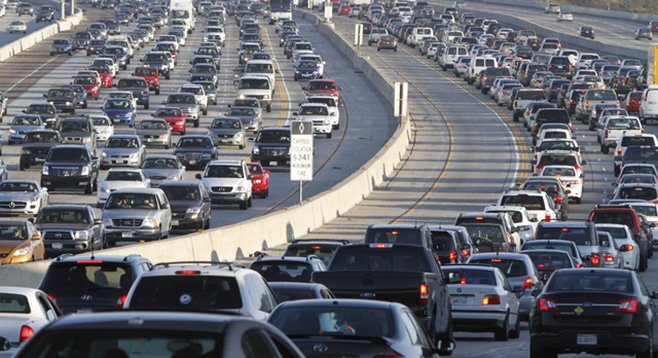 Facebook
Facebook
 X
X
 Instagram
Instagram
 TikTok
TikTok
 Youtube
Youtube

New criticism of the San Diego Association of Governments (SANDAG) plan to manage transportation in the coming decades has arisen as the group prepares to consider a revised transit plan this week.
The Cleveland National Forest Foundation, which mounted a successful legal challenge to SANDAG's original plan three years ago, joins other local climate action groups in lamenting the revised plan's shortcomings.
The crux of the foundation's complaint is that, despite an unexpected leveling-off in total vehicle miles traveled since the initial SANDAG plan was released in 2007, no changes have been made to the total proposed amount of new road construction, largely composed of freeway expansion that includes expansion of bus and carpool lanes.
"The 2015 Draft Regional Transportation Plan (DRTP) has partially responded to these changes by Forecasting much lower growth in VMT [vehicle miles traveled] in the future. In fact, the 2015 DRTP forecasts that 2050 VMT will be lower than the VMT that was forecast for today only 8 years ago," reads a Smart Mobility, Inc., report commissioned by the foundation. "Nevertheless, the DRTP keeps all of the road projects that were in the 2007 and 2011 RTPs."
What has changed, however, is the cost of building new roadways — according to the report, projected costs have soared by 27 percent, and the funding shortfall is to be made up by reducing investment in mass-transit projects, a part of the plan critics argue was already being short-changed.
"This [plan and accompanying environmental report] documents that this road-heavy plan will fail to meet California’s 2050 goals for reducing CO2 emissions from cars and trucks," continues the report.
State law enacted in 2008 calls for overall reductions in air pollution with benchmarks to be met by 2020, 2035, and 2050. None of the goals are expected to be met under the existing plan, which anticipates that population growth and increased reliance on personal vehicles will result in greater overall emissions in the future rather than a reduction from current pollution rates.
Instead of planning for more roads, the foundation says, SANDAG needs to instead focus its attention on a "transit first" strategy, pushing investment in bus and light rail systems, as well as pedestrian- and cyclist-friendly improvements, to the early stages of the transit plan.
"To meet [emissions] goals SANDAG needs to drastically reshape the DRTP by removing all projects that increase roadway capacity" and instead develop a "world class transit system."
SANDAG officials are set to consider the latest transportation plan update later this week.


New criticism of the San Diego Association of Governments (SANDAG) plan to manage transportation in the coming decades has arisen as the group prepares to consider a revised transit plan this week.
The Cleveland National Forest Foundation, which mounted a successful legal challenge to SANDAG's original plan three years ago, joins other local climate action groups in lamenting the revised plan's shortcomings.
The crux of the foundation's complaint is that, despite an unexpected leveling-off in total vehicle miles traveled since the initial SANDAG plan was released in 2007, no changes have been made to the total proposed amount of new road construction, largely composed of freeway expansion that includes expansion of bus and carpool lanes.
"The 2015 Draft Regional Transportation Plan (DRTP) has partially responded to these changes by Forecasting much lower growth in VMT [vehicle miles traveled] in the future. In fact, the 2015 DRTP forecasts that 2050 VMT will be lower than the VMT that was forecast for today only 8 years ago," reads a Smart Mobility, Inc., report commissioned by the foundation. "Nevertheless, the DRTP keeps all of the road projects that were in the 2007 and 2011 RTPs."
What has changed, however, is the cost of building new roadways — according to the report, projected costs have soared by 27 percent, and the funding shortfall is to be made up by reducing investment in mass-transit projects, a part of the plan critics argue was already being short-changed.
"This [plan and accompanying environmental report] documents that this road-heavy plan will fail to meet California’s 2050 goals for reducing CO2 emissions from cars and trucks," continues the report.
State law enacted in 2008 calls for overall reductions in air pollution with benchmarks to be met by 2020, 2035, and 2050. None of the goals are expected to be met under the existing plan, which anticipates that population growth and increased reliance on personal vehicles will result in greater overall emissions in the future rather than a reduction from current pollution rates.
Instead of planning for more roads, the foundation says, SANDAG needs to instead focus its attention on a "transit first" strategy, pushing investment in bus and light rail systems, as well as pedestrian- and cyclist-friendly improvements, to the early stages of the transit plan.
"To meet [emissions] goals SANDAG needs to drastically reshape the DRTP by removing all projects that increase roadway capacity" and instead develop a "world class transit system."
SANDAG officials are set to consider the latest transportation plan update later this week.
Comments